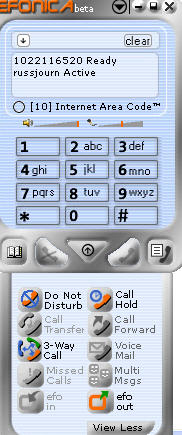For efonica's softphone client, a mixed verdict


After being quite impressed with Windows Live Messenger, I then decided to give efonica a whirl.
That's the new softphone from New York-based Fusion Telecommunications International.
Calls are cheap- 1.8 cents a minute. They go through clearly. The set-up is a bit unusual. The feature-set offers some cool amenities but some that are glaringly absent.
First, you have to register with the service, and then you enter your existing landline or cell numbers. Then, you receive a "worldwide Internet area code" (10), which you then dial before your phone number.
There is a free domestic and international calling option, but both your number and the one you are dialing have to be registered wih efonia. If not, your calls are 1.8 cents a minute to the U.S. and Canada, 1.9 cents a minute to several other nations, and generally quite inexpensive to much of the rest of the world.
In terms of positives, the feature set supports caller ID with name (a glaring omission in some other VoIP provider calling plans),call waiting, call forwarding, three-way-calling, call hold and do not disturb. No premium- these are all free of charge.
On the other hand, there is no inbound calling as of yet. Efonica says it is coming, but doesn't give a time frame.
The most glaring shortcoming, however, is that efonica is pretty much a call-specific client. Unlike other softphones, there's no handy backchannel for IM, and integrated phone number and address books. And unlike Windows Live Messenger, account information requests do not show natively and handily in the GUI, but in a separate browser window that opens up when you click the appropriate icon directly below the phone dial pad.
My assessment: the calling features are exactly what is needed, but unless you do a lot of regular international calling to a specific set of numbers, why bother when you can get similar free calling via a client that offers IM as well?